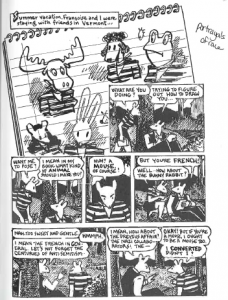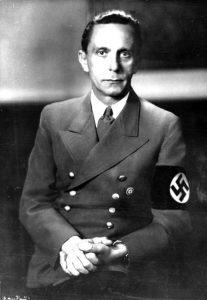As I read J. David Bolter and Richard A. Grusin’s “Remediation,” I could not help but think of my favorite graphic narrative to read, to teach, to obsess over: Art Spiegelman’s Maus.
Bolter and Grusin begin their article by analyzing the film Strange Days and arguing for its use of remediation: “In addressing our culture’s contradictory imperatives for immediacy and hypermediacy, the film enacts what we understand as a double logic of ‘re-mediation.’ Our culture wants both to multiply its media and to erase all traces of mediation: it wants to erase its media in the very act of multiplying technologies of mediation” (313). This double logic reminds me of an ongoing debate about Holocaust literature and art. Seventy years later, as survivors and scholars continue to grapple with the question of representation, there is both a desire to capture individual, unique memories and the need to ensure proper remembrance through specific, appropriate media.
In Maus, which won the 1992 Pulitzer Prize, Spiegelman sketches his interactions with Vladek, Spiegelman’s father, as he tells his son about his experience as a Jew in Poland during World War II. Throughout the narrative, Spiegelman portrays both the process of interviewing and interacting with his father in the 1970s and 1980s and the memories Vladek shares about his early life and the Holocaust.
Spiegelman portrays both the process of interviewing and interacting with his father in the 1970s and 1980s and the memories Vladek shares about his early life and the Holocaust.
Much of the graphic memoir fits within Bolter & Grusin’s framework of hypermediacy. They quote William J. Mitchell when they explain hypermediacy as a visual style “that privileges fragmentation, indeterminacy, and heterogeneity and that emphasizes process or performance rather than the finished art object” (327). While the majority of the content of Maus consists of Spiegelman’s cartoon drawings of mice, cats, and other zoomorphic characters, there are several noticeable breaks in this physical portrayal. The first comes in the opening volume with the inclusion of “Prisoner on the Hell Planet,” a cartoon first published in 1973 depicting – with human drawings and very different sketching – the suicide of Spiegelman’s mother, Anja. Spiegelman also scatters several family photographs from the first half of the 20th century throughout the text. The dedication page of the second volume contains a single black-and-white photo of Richieu, Art’s brother who died during the war, and black-and-white picture of Vladek in his Auschwitz uniform appears in the first volume. Much has been written about the representation of humans as animals in Maus, especially because different religions and ethnicities are portrayed as different, sometimes controversial, species. Critics pay far less attention to these significant breaks in the zoomorphic mode, which serve as reminders of the fluidity and inexplicability – the hypermediacy – of Spiegelman’s work. Maus consistently rejects a singular medium of communication, even as it embraces the traditional formal conventions of comics.
And yet, even within the zoomorphic drawings, Spiegelman calls attention to his  role as cartoon artist, reminding his readers of the medium in which his narrative is conveyed. In this way Maus captures the logic of hypermediacy, which “calls for representations of the real that in fact multiply the signs of mediation and in this way try to reproduce the rich sensorium of human experience” (329-330). Spiegelman inserts his presence more overtly than most artists, reversing the “erasure” that characterizes immediacy. Rather than “effacing his process and thereby himself,” Spiegelman instead outlines his project in various stages by including sketches of himself as human with a mouse mask and of his drawings (320). The example above shows the artist’s sketchpad with a variety of animals in the same shirt. In the panels that follow, Spiegelman talks with his wife about how to portray her accurately in the narrative because she is French, not Jewish. This meta-narrative reinforces the hypermediacy of Maus.
role as cartoon artist, reminding his readers of the medium in which his narrative is conveyed. In this way Maus captures the logic of hypermediacy, which “calls for representations of the real that in fact multiply the signs of mediation and in this way try to reproduce the rich sensorium of human experience” (329-330). Spiegelman inserts his presence more overtly than most artists, reversing the “erasure” that characterizes immediacy. Rather than “effacing his process and thereby himself,” Spiegelman instead outlines his project in various stages by including sketches of himself as human with a mouse mask and of his drawings (320). The example above shows the artist’s sketchpad with a variety of animals in the same shirt. In the panels that follow, Spiegelman talks with his wife about how to portray her accurately in the narrative because she is French, not Jewish. This meta-narrative reinforces the hypermediacy of Maus.
Because of the highly emotional, personal, and disturbing nature of his content, Spiegelman carefully considered the representation of his narrative. Rather than simply drawing his family as humans – something he did frequently as a comics artist – Speigelman chose to depict them, and other historical individuals, as animals. This visual presentation of the Holocaust insists on separating characters by religion and nationality and therefore highlights the destructive and dehumanizing methods of the Nazis in their quest for Aryan perfection. The artist himself admits he chose to draw the Jewish victims as mice because he wanted to reclaim and reconceptualize the propaganda put forth by Joseph Goebbels, Hitler’s propaganda minister, who rendered Jews as rats infesting Germany.
Thus, Maus seems to serve as a prime example of Bolter & Grusin’s remediation. Even as it includes and comments on other media (photographs, maps, differently styled comics), the narrative reflects on its own process and the inseparability of mediation and reality. Spiegelman spent decades constructing his most famous work, struggling with how best to represent his father’s memories alongside his own. In the end, the canonical graphic narrative exemplifies the “process of reforming reality,” shaping the way in which comic artists create and scholars view Holocaust texts (346).

Great example of remediation! There is so much going on in Maus with memory, which is one of the classical canons, and Eyman spends quite a bit of time discussing it as it relates to digital rhetoric. Memory can be invoked, remediated, constructed or reconstructed, as it is here. You might be interested in this: http://cmsimpact.org/resource/holocaust-museum-repackages-multimedia-propaganda-exhibit-for-media-literacy-educators/
While there is plenty published and posted about media during the Holocaust/propaganda, and even a story on how the NYT missed it while it was happening, http://historynewsnetwork.org/article/10903
I haven’t seen much about how post-war media has reshaped perception of the Holocaust–although it plays a large part in modern politics.
Professor,
Thank you for mentioning memory! I thought about including some thoughts about the classical rhetorical canon, but I didn’t want to stray too far from remediation because there was much to discuss there.
I have written several papers and researched Maus over the course of my two graduate programs, but I am always finding new ways to read it, including Bolter & Grusin now! I was struck again while I wrote about their perspective (and others this week) on the interplay of content and form. Much has been analyzed about Spiegelman’s own reflection on form, but the idea of (re)mediating one’s self has me thinking about his work – and his shaping of graphic narratives and Holocaust media – in a different light.
When I was reading for this week, there were multiple times when I thought, “I hope Sarah writes about Maus.” Glad that you did! I enjoyed reading this different angle on the text. I know you’ve talked about the graphic elements before, but I didn’t know there was so much remediation going on (particularly with family photographs and things of that nature).
Thank you for your gracious reply, Jon! I was hoping not to annoy you and Caitlin with yet another reflection on Spiegelman. But, as you know, I am always re-thinking graphic narratives, and because I know Maus best, I wanted to explore Bolter & Grusin through that familiar lens.
Nope, I’m not annoyed either! As I was reading your blog post, I remembered the observation you made in Proseminar that characters’ tails disappear and reappear throughout Maus (did I get that right?). This fits perfectly within Bolter & Grusin’s concept of fragmentation within hypermediacy, as well as within your own reflections on the topic. It’s really fascinating how these “breaks” in the imaginative world and the reminders of the the artist’s existence can add to the “reality” and immersion of a given text.
Anyway, great post! Never feel fear when writing about Maus, I will always love it! 🙂
Hi Sarah, great post! It was interesting that you brought out Spiegelman’s presence and hypermediacy through his method of reinterpreting humans as representing the traits of various animals. I appreciated the reminder of “Remediation” through your chosen quotes.